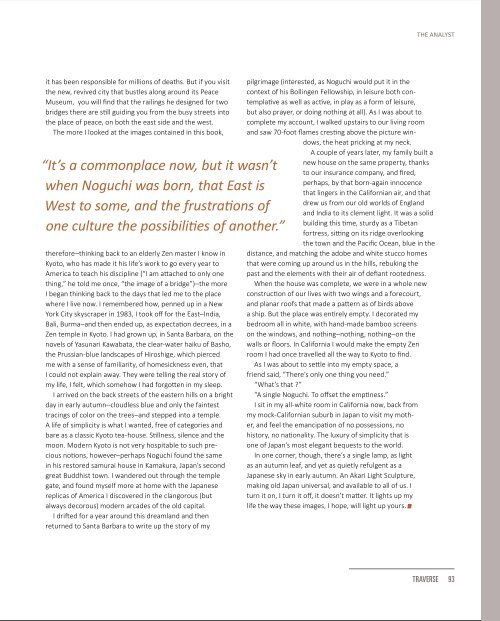Create successful ePaper yourself
Turn your PDF publications into a flip-book with our unique Google optimized e-Paper software.
THE ANALYST<br />
it has been responsible for millions of deaths. But if you visit<br />
the new, revived city that bustles along around its Peace<br />
Museum, you will find that the railings he designed for two<br />
bridges there are still guiding you from the busy streets into<br />
the place of peace, on both the east side and the west.<br />
The more I looked at the images contained in this book,<br />
“It’s a commonplace now, but it wasn’t<br />
when Noguchi was born, that East is<br />
West to some, and the frustrations of<br />
one culture the possibilities of another.”<br />
therefore–thinking back to an elderly Zen master I know in<br />
Kyoto, who has made it his life’s work to go every year to<br />
America to teach his discipline (“I am attached to only one<br />
thing,” he told me once, “the image of a bridge”)–the more<br />
I began thinking back to the days that led me to the place<br />
where I live now. I remembered how, penned up in a New<br />
York City skyscraper in 1983, I took off for the East–India,<br />
Bali, Burma–and then ended up, as expectation decrees, in a<br />
Zen temple in Kyoto. I had grown up, in Santa Barbara, on the<br />
novels of Yasunari Kawabata, the clear-water haiku of Basho,<br />
the Prussian-blue landscapes of Hiroshige, which pierced<br />
me with a sense of familiarity, of homesickness even, that<br />
I could not explain away. They were telling the real story of<br />
my life, I felt, which somehow I had forgotten in my sleep.<br />
I arrived on the back streets of the eastern hills on a bright<br />
day in early autumn–cloudless blue and only the faintest<br />
tracings of color on the trees–and stepped into a temple.<br />
A life of simplicity is what I wanted, free of categories and<br />
bare as a classic Kyoto tea-house. Stillness, silence and the<br />
moon. Modern Kyoto is not very hospitable to such precious<br />
notions, however–perhaps Noguchi found the same<br />
in his restored samurai house in Kamakura, Japan’s second<br />
great Buddhist town. I wandered out through the temple<br />
gate, and found myself more at home with the Japanese<br />
replicas of America I discovered in the clangorous (but<br />
always decorous) modern arcades of the old capital.<br />
I drifted for a year around this dreamland and then<br />
returned to Santa Barbara to write up the story of my<br />
pilgrimage (interested, as Noguchi would put it in the<br />
context of his Bollingen Fellowship, in leisure both contemplative<br />
as well as active, in play as a form of leisure,<br />
but also prayer, or doing nothing at all). As I was about to<br />
complete my account, I walked upstairs to our living room<br />
and saw 70-foot flames cresting above the picture windows,<br />
the heat pricking at my neck.<br />
A couple of years later, my family built a<br />
new house on the same property, thanks<br />
to our insurance company, and fired,<br />
perhaps, by that born-again innocence<br />
that lingers in the Californian air, and that<br />
drew us from our old worlds of England<br />
and India to its clement light. It was a solid<br />
building this time, sturdy as a Tibetan<br />
fortress, sitting on its ridge overlooking<br />
the town and the Pacific Ocean, blue in the<br />
distance, and matching the adobe and white stucco homes<br />
that were coming up around us in the hills, rebuking the<br />
past and the elements with their air of defiant rootedness.<br />
When the house was complete, we were in a whole new<br />
construction of our lives with two wings and a forecourt,<br />
and planar roofs that made a pattern as of birds above<br />
a ship. But the place was entirely empty. I decorated my<br />
bedroom all in white, with hand-made bamboo screens<br />
on the windows, and nothing–nothing, nothing–on the<br />
walls or floors. In California I would make the empty Zen<br />
room I had once travelled all the way to Kyoto to find.<br />
As I was about to settle into my empty space, a<br />
friend said, “There’s only one thing you need.”<br />
“What’s that ?”<br />
“A single Noguchi. To offset the emptiness.”<br />
I sit in my all-white room in California now, back from<br />
my mock-Californian suburb in Japan to visit my mother,<br />
and feel the emancipation of no possessions, no<br />
history, no nationality. The luxury of simplicity that is<br />
one of Japan’s most elegant bequests to the world.<br />
In one corner, though, there’s a single lamp, as light<br />
as an autumn leaf, and yet as quietly refulgent as a<br />
Japanese sky in early autumn. An Akari Light Sculpture,<br />
making old Japan universal, and available to all of us. I<br />
turn it on, I turn it off, it doesn’t matter. It lights up my<br />
life the way these images, I hope, will light up yours.<br />
<strong>TRAVERSE</strong> 93



